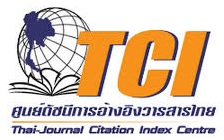A Corpus-Based Vocabulary Selection for Grades 1-3 Thai EFL Learners
Keywords:
corpus-based vocabulary list, รายการคำศัพท์ที่มาจากคลังคำศัพท์, high-frequency words, คำศัพท์ที่ มีความถี่สูง, grades 1-3, ชั้นประถมศึกษาปีที่ 1-3, EFL/ESL learners, นักเรียนที่เรียนภาษาอังกฤษเป็น ภาษาต่างประเทศ/ภาษาอังกฤษเป็นภาษาที่สองAbstract
Vocabulary is one of the key components of successful language learning because it is central to learners’ communicative competence. Therefore, essential words EFL/ESL students need to learn mustbe well selected for effective teaching and efficient learning. Since there are no research-based English vocabulary lists for Grades 1-3 students, this research study aimed to find a list of the first 500 words most frequently appearing in textbooks that young learners needed to learn and to compare the list with three other most frequently quoted lists. A corpus of 146,192 running words was compiled from 501 lessons of the 14 series of textbooks. From this initial corpus, a total of 3,818 word types in frequency rank were identified from running the Range GSL and manually lemmatized to extract all base forms. As a result, the Most Frequent 500-Word List for Grades 1-3 was yielded. To further validate the word list, the percentage of overlap between this word list and three popular word lists, namely the General Service List, the Oxford Word List, and the Dolch Basic Word List, was examined. The results showed a very high percentage of overlapped words between each of them and the Most Frequent 500-word list.
References
Astika, G. (1993). Analytical assessment of foreign students writing, RELC Journal, 24 (1): 61-72.
Bauman, J. and Culligan, B. (1995). About the General Service List. Retrieved on August 21, 2008 from http://
jbauman.com/gsl.html.
Carter, R. & McCarthy, M. (1988). Word lists and learning words: some foundations. In R. Carter & M. McCarthy
(ed.); Vocabulary and language teaching (pp. 1-17). NY: Longman.
Chujo, K., Nishigaki, C., and Utiyama, M. (2007). Selecting 500 essential daily-life words for Japanese EFL elementary students from English picture dictionaries and a children’s spoken corpus. Proceedings of Inaugural International Conference on the Teaching and Learning of English in Asia, Malaysia. Retrieved on January 6, 2008 from http://mastarpj.nict.go.jp/~ mutiyama/ pdf/ chujo-nishigaki-utiyama.pdf.
Coxhead, A. (2000). A new academic word list. TESOL Quarterly, 34(2), 213-38.
Dale, E. and Chall, J.S. (1948). Dale-Chall word list. Retrieved on August 25, 2008 from http://www.rfptemplates.
com/Dale-Chall-List-of-3000-Simple- words.html#The_Dale-Chall_Word_List
Engels, L.K., Beckhoven, B.V., Leenders, T., and Brasseur, I. (1981). L.E.T. Vocabulary-list. Acco: Leuven.
Harris, A.J. and Jacobson, M.D. (1972). Basic elementary reading vocabularies. New York: Macmillan.
Hindmarsh, R. (1980). Cambridge English lexicon. Cambridge: Cambridge University Press.
Ito, K. (2000). Elementary school education. Ready? Go!. Tokyo: G yousei.
Kuno, Y. (1999). How about starting elementary school English like this? Tokyo: Sanseido.
Laufer, B. (1994). The lexical profile of second language writing: Does it change over time? RELC Journal, 25(2), 21-32.
Laufer, B. and Nation, I.S.P. (1995). Vocabulary size and use: Lexical richness in L2 written production. Applied Linguistics. 16(3), 306-322.
Lee, S.L. and Munice, J. (2006). From respective to productive: Improving ESL learners’ use if vocabulary in a
post reading composition task. TESOL Quarterly, 40(2), 295-320.
Lo Bianco, J., Scull, J., and Ives, D. (2008). The words children write. South Melbourne: Oxford University Press.
Mackey, W.F. (1965). Language teaching analysis. London: Longman.
McCarty, M. (1990). Vocabulary. East Kilbride: Oxford University Press.
Ministry of Education. (2001a). Basic education: Core curriculum. Bangkok: Academic Department, MOE.
Ministry of Education. (2001b). Basic education: Foreign language curriculum. Bangkok: Academic Department, MOE.
Nation, I.S.P. (1993). Measuring Readiness for Simplified Material: A Test of the First 1,000 Words of English. In
M. L. Tickoo (ed.) RELC Anthology Series, No. 31, 193-203.
Nation, I.S.P. (2001). Learning vocabulary in another language. Cambridge: Cambridge University Press.
Nation, P. and Waring, R. (1997). Vocabulary size, text coverage and word lists. In N. Schmitt and M. McCarthy
(ed.), Vocabulary: Description, acquisition and pedagogy (pp. 6-19). Cambridge: Cambridge University
Press.
Thorndike, E. and Lorge, I. (1944). The teacher’s word book of 30,000 words. New York: Bureau of Publications,
Teachers College, Columbia University.
West, M. (1953). A general service list of English words: with semantic frequencies and a supplementary word-list for the writing of popular science and technology. London: Longman.





 ThaiJO
ThaiJO